Ingemar Borelius
I believe we all could agree that some dogs have that little extra quality that make them the great winners. It requires a great trainer no doubt to win consistently in strong competition, but no matter how good you are you don’t go to the top if you haven’t got a special dog.
It’s obvious that most great British workers came from the Claverdon line, being the undoubtable backbone of the British working Flatcoat over half a century. Looking at the litterbrothers Varingo Richboy and Stormbrook that is definitely the case, with four close lines back to the littermates Claverdon Lucretia and Lysander.
When it comes to Reltub Black Velvet, for me the greatest son of Varingo Richboy, the balance is somewhat different. His pedigree is showing a close linebreeding to the littermates Feather Boa at Varingo and Bell Hop and three close lines back to Joan Marsdens great FT winner, Wemdom Bright Bond of Tarncourt and his sibling Wemdom Barton Lass.
But it’s obvious as well that there are many other strong components behind those dogs from the Collyers, Tarncourt and Warresmere kennels, with the International FT Champion Hartshorn Sorrel, FT Ch Werrion Redwing and FTW Tarncourt Noteable clearly visible in their pedigrees. There is a strong similarity to the breeding behind the latest British Flatcoat FT Champion Shirlett Sweetheart as well. She was never bred from, but you could say for sure that all the greatest names in the British modern working Flatcoated Retriever history are covered in the breeding behind these three great dogs.
I asked Chris Gwilliam the breeder of Varingo Richboy, Alex Faarkrog, the owner of Varingo Stormbrook and Annika Christiansen, the owner of Reltub Black Velvet, to tell their stories about those great dogs and this is their responses.
Varingo Richboy (Claverdon Raffles of Collyer x Feather Boa at Varingo, Born 1994)
Varingo Richboy or “Ben”, as he was known to us at home, was out of Feather Boa at Varingo being purchased from Ken Butler as a puppy. She was a very kind and biddable bitch, and did very well in field trials though she never won, and she was a very good game finder. I decided to breed from her as she was a hard hunter with good game finding abilities that would tackle any cover. I put her to Claverdon Raffles of Collyers, owned by the late Amelia Jessel. The decision was purely based on the fact that he was very well bred for working and had done well in trials. As with any litter you breed, you always try to combine the best qualities and hope it works out well – in this case it did.
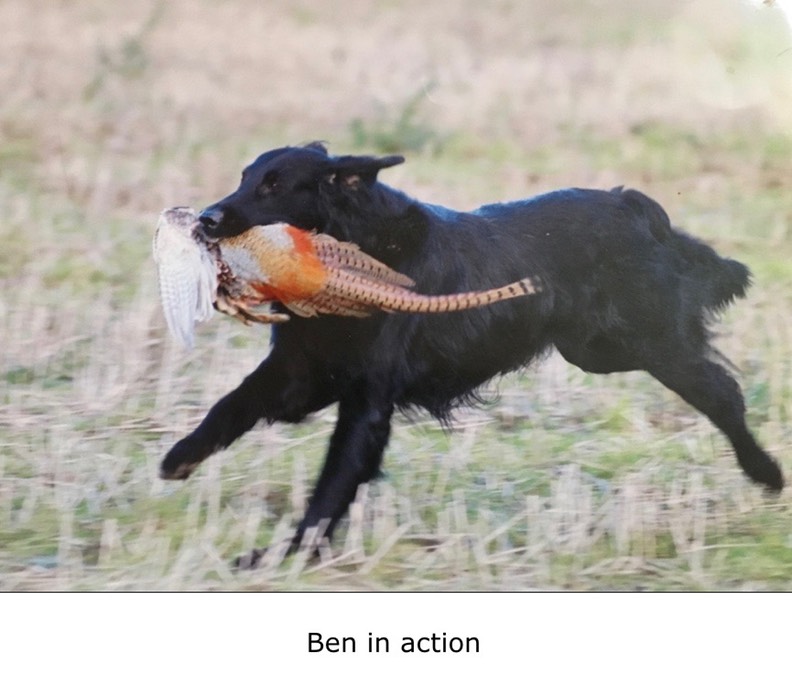
“Bens” working ability was exceptional, always rock steady, and silent with a soft mouth. My daughter Laura ran him in her first field trial when she was 13, and won a field trial award with him. His versatility shown again when my other daughter Sarah won a working test with him when she was 15.
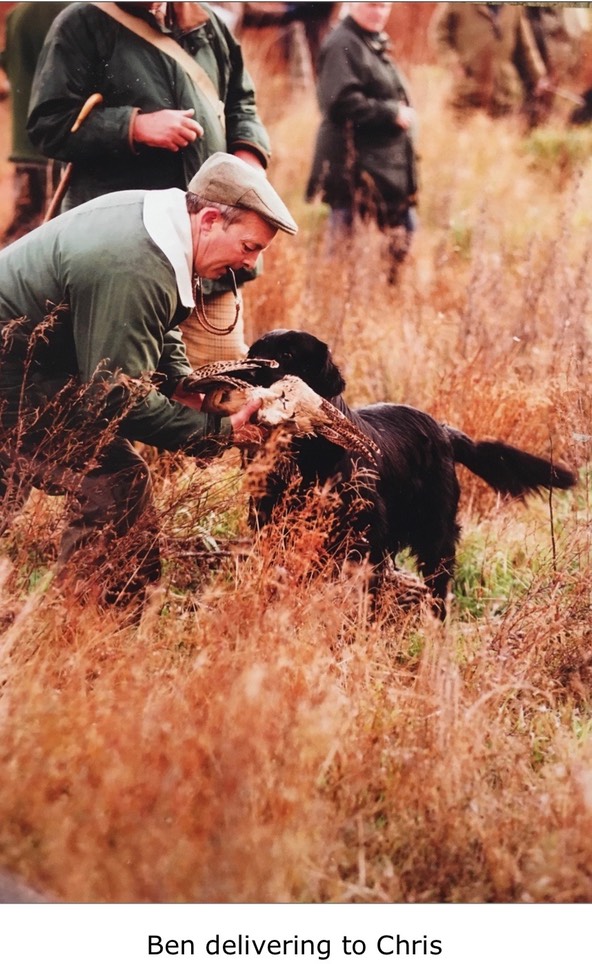
Ben won many field trials and was placed in Any Variety Trials. He won the Flatcoat Open Field Trial Stake 3 times. His best performance was in the Kennel Club 2 day Any Variety stake, which was considered to be the equivalent of the Retriever Championship, which he gained an award in. There was only 4 of us left on the second day. We were walking up in sugar beet, with a lot of game in front of us – when 6 birds all got up at once. We were under a lot of pressure with all the game and gun shoots. He leaned against my leg and remained steady. I went to touch him to say well done, the judge saw me and it cost me the trial. I therefore only gained a certificate of merit.
I would say he had many good retrieves in trials, but the best was a towering bird more than 100m off the end of the line. The retrieve would have been about 150m from us, as we were on the other end of the line. The line was moved back, I sent Ben for the bird and he went through the sugar beet ignoring all the other game. He had marked it right to the spot, and brougt it back as fast as he could.I can’t remember him doing his early training, but I think he had good and bad days, like all of them have.
I think his strongest point was his steadiness, he never ever moved, and always waited to be sent. I’ve done many demonstrations on his steadiness, using othr dog and live game.
I can’t remember him doing his early training, but I think he had good and bad days, like all of them have.
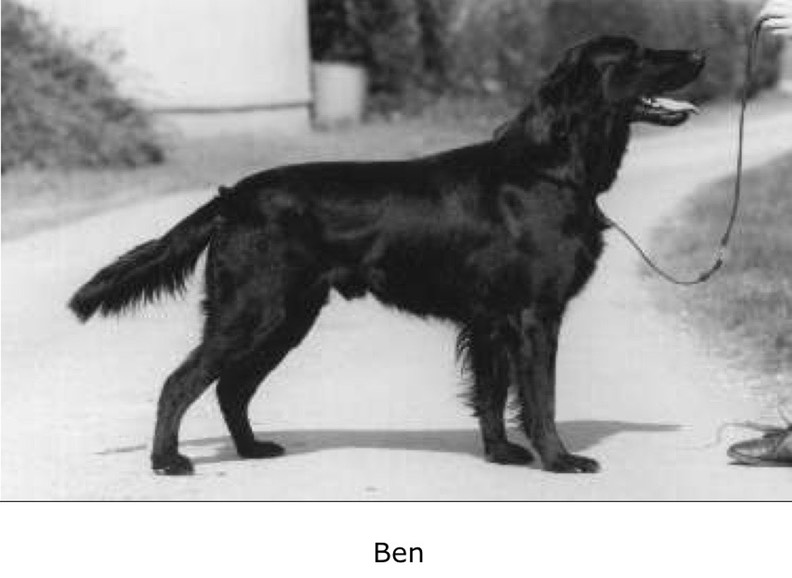
He was a top flatcoat over here for 5/6 years, which included winning in Field Trial classes at Crufts. Other than team events, I do not think Ben was ever beaten in any Working test – but those are too numerous to mention.
I am sure that Richboy is in the pedigrees behind a large share of all working Flatcoats in Britain today, and I am proud about his strong contribution to the working Flatcoat. Richboy was a very special dog, and I don’t think I will ever have another one that equals his supreme abilities.
DKJCH DKBRCH NOJCH SEJCH NORDJCH Reltub Black Velvet (Varingo Richboy x Reltub Flirtacious Flossy, 2000 -2012)
The story began with a bitch pup, called Queeny, that I obtained from a local gamekeeper. It was a bit of a funny story as I swapped some oil to get her, when changing from oil to natural gas in our business. Queeny made me interested in training and trialling but it showed quite soon that she was a bit too exitable, being unable to keep quiet under hot conditions. I realised that I had to find a breeder focusing on working Flatcoats if I wanted to compete at higher levels.
I might have been a bit brash when I got in touch with Amelia Jessel and asked for a visit. But she invited me most kindly to her Flatcoat world, she shared her great wisdom when it came to working Flatcoats, she told me the history about the breed and taught me about the bloodlines to look for.
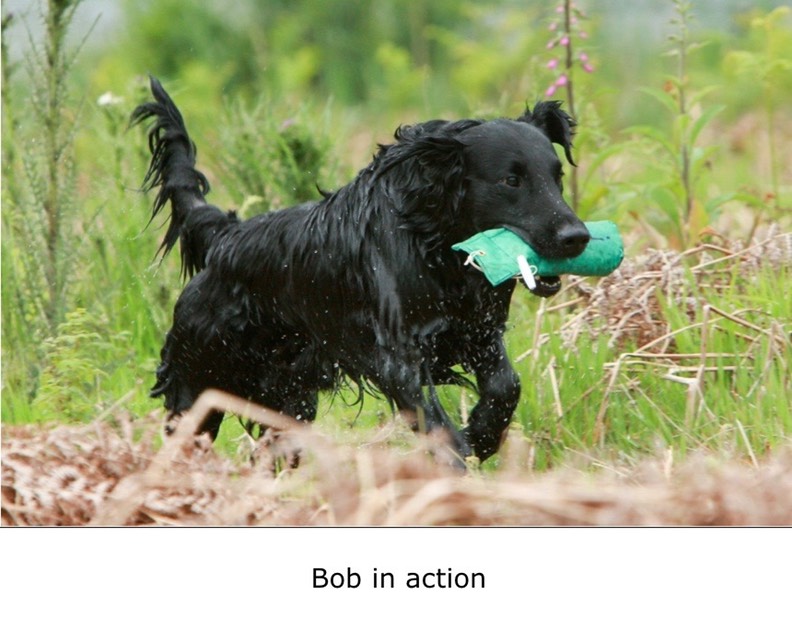
Then I moved on to visit Chris Gwilliam. He told about his dog, Varingo Richboy, and gave me an opportunity to watch him at work. When I was about to leave Chris told about a recent mating between Richboy and Reltub Flirtacious Flossy, which was supposed to be an excellent combination to bring to Denmark. I got in touch with Kate Butler who was somewhat reluctant at first to the idea of bringing a pup out of the country. But with some persuasion I was allowed to buy a dog pup. When I got there to fetch Bob he was already selected. It was just about to take him or leave him.
Having Queeny as my first retriever, I made all the faults I could when I trained her, and I didn’t want that to happen again. I got in touch with a well-known trainer, being active in the independent Danish ”Working Retriever Club (Retrievernes Jagthunde Klub), providing private training sessions. I went to him when Bob was six months old and I continued until he was three years. The man had made up a number of Labradors to become FT Champions, he became my mentor and he taught me everything I know about gundog training.
When it came to Bob’s education, he was an easily trained dog. I showed it a few times and he always made his best to understand me. But it must be said that I loved to train him. I used 15 hours a week for training. I could go out dark evenings and use the” ball thrower” and use all my power to get the ball far out in the woods and allow him to search independently. He always found it and it gave him self-confidence.
He was not the kind of dog who excelled when it came to free search on large areas and I could see from the result lists that those occasions weren’t his best moments. His strong point was his outstanding ability to work with me and willingly take directions. He always trusted me. I always payed attention to being in the right position where he could easily see me, and I was always absolutely sure where I had thrown the dummy.
Bob won his first A-Test (Field Trial) with a certificate in 2002 when he was 2 years and 9 months old. He participated in many trials and I can’t remember all the details that made him the winner at all these occasions. But he was always” in my hands” and he understood instinctively that if the other dog had been there he shouldn’t go to the same spot. He could easily let go what the other dogs had done and concentrate fully on his own task.
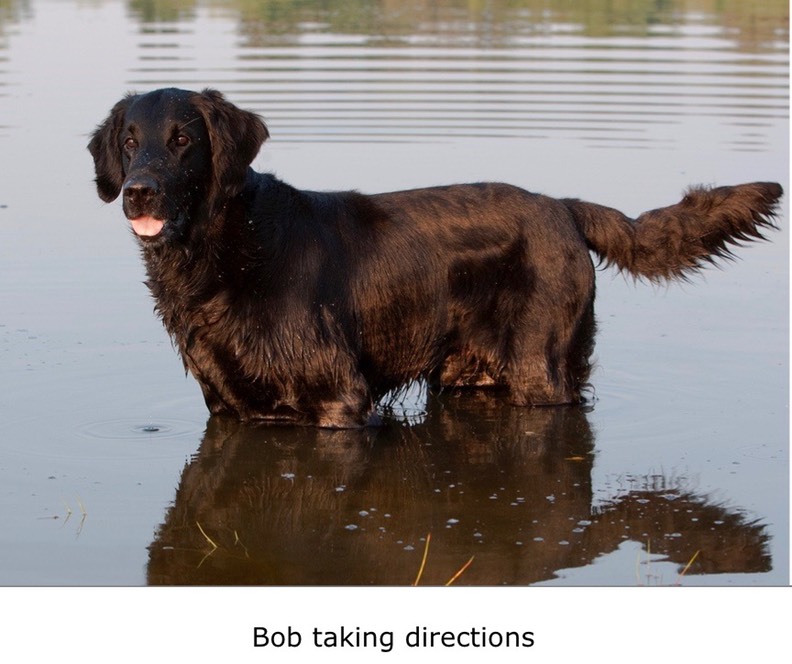
Once at the Elite-test (The Danish Retriever Championship for any variety retrievers) two birds were down to the right and to the left of the line where ten dogs were standing. All dogs must have seen the two birds but seemingly no one has seen a bird that was down in front of the line behind a hill. The first dogs were sent for the two birds to the right and to the left. When these were picked a dog was sent for the bird in front of the line but it rushed towards the side of the line and it was called in. That happened with the following four dogs as well. When it was my turn I pointed at both sides saying NO and send Bob straight out with a BACK command, he took the line, moved straight out for 100 meters, disappeared behind the hill and after a thrilling moment the gun was rasing his hand to declare that the bird was found. That was a magic moment that I will never forget!
At another A-test, at a shooting ground where a large number of birds were shot, Bob was the winner with a certificate after having retrieved 54 pieces of game. That’s never happening today at Danish A-tests where no dogs are supposed to pick more than 8 – 15 birds.
I remember his very first A-test which was a magic moment as well. Birds were few so if was difficult to find decent retrieves for all the dogs. We were sent for everything even if some of the birds were quite impossible to manage. We were standing in a line in front of a plantation with fir trees close to 300 meters ahead of us were birds were supposed to nest. Three birds were shot, two went down dead openly but the third was winged flowing over the fir trees. I knew it was my turn and I knew that bird was mine as the birds visibly on the ground were dead and could be managed later. Bob had marked the winged bird, I told his name and off he went with good speed and on a straight line directly into the woods. He was off hunting for about three minutes in the tight forest and it was a magic moment when he turned back with the winged pheasant in his mouth.
When I’m sitting her, writing about him it comes over me that I miss him immensely... He was a human like dog, understanding every word when you talked to him. He was quite spoiled, sleeping in my bed every night and he was the constant companion. He loved all humans and other dogs, he was in no way a dominant dog trying to challenge other dogs and although he mated many bitches he was not the kind of dog who tried to cover bitches at every possible occasion. When we woke up every morning and I asked him if” mummy’s dog had slept well” he always responded with a wolf like howl, which I loved!
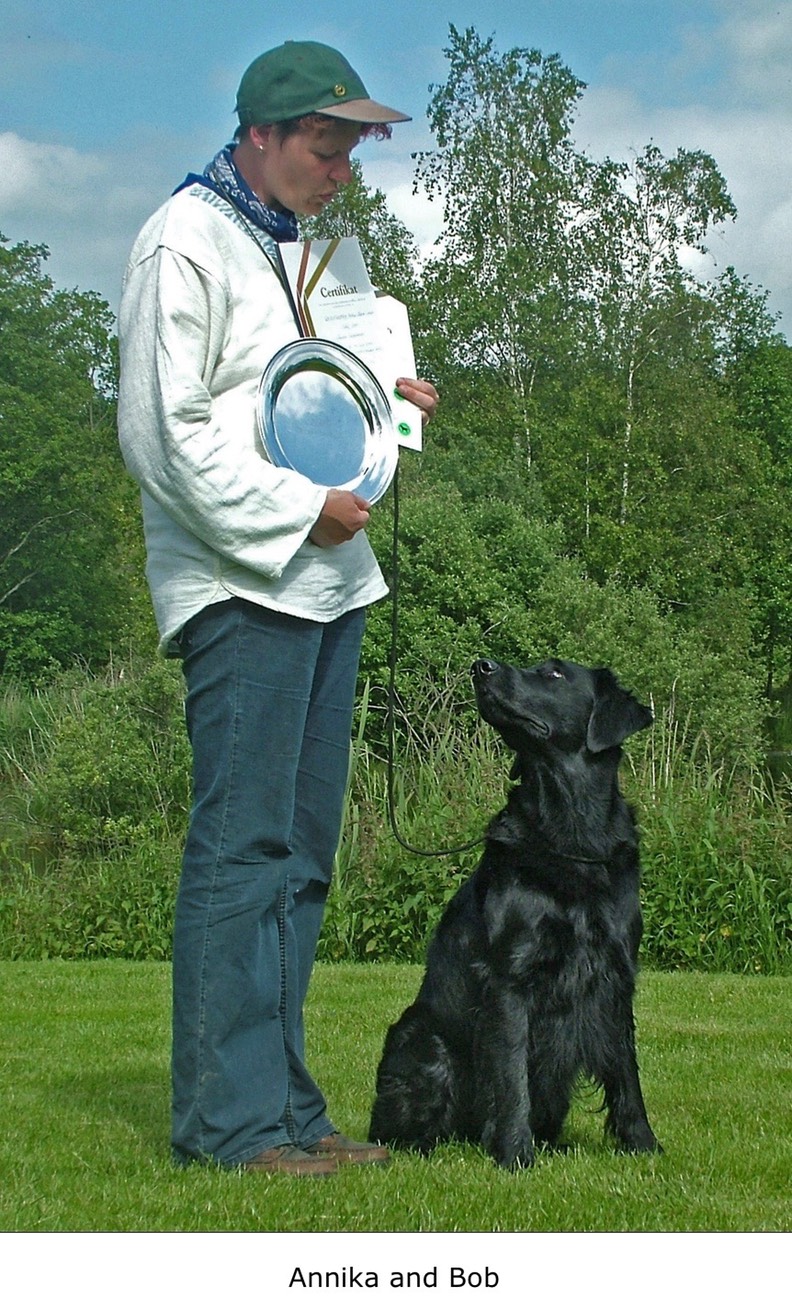
Bob won many trials, he became a” Jakt Champion” (Cold game) in Denmark (DK BRCH), Norway (NO JCH) and Sweden (SE JCH) making him a Nordic “Jakt Champion”. He was the first Flatcoat ever to gain a Danish “Jakt Champion” title on warm game and he won the Danish Retriever Championship (Retrievermesterskap) on cold game in 2005 beating 76 other dogs, mainly Labradors. He won the Swedish Flatcoat Championship (Flatmästerskapet) in 2004 and was the best veteran at the Swedish Flatcoat Championship and the Norwegian Retriever Championship (cold game, any variety) in 2008 and 2009. He participated in Skinners cup, in Britain, two times but he was not in the awards.Among his offspring I would particularly like to point out the bitch Coatfloats Marimekko, owned and handled by Ingela Karlsson, a fantastic bitch with an impressing career. Among numerous great results she won one A-test, one B-test, with a certificate, and one C-test (Working test) in Denmark, she won the individual Nordic Flatcoat Championship in 2011 and 2015, she was a member of the winning Swedish team at the Nordic Flatcoat Championship for 7 consecutive years between 2011 – 2016, the last time being 10,5 years old, and she had a Certificate of Merit at a British Open Any Variety Field Trial.
Another great bitch was my own Seamasters Eternity. Unfortunately, she had a quite short career, being put down due to an accident at six years of age. But she had a sparkling career winning the very first individual Nordic Championship in 2008, with an A-test certificate, and winning the International Field Trial in Denmark with a CACIT the same year, being the first Flatcoat ever to win a CACIT at a Field Trial (at least one Swedish Flatcoat won a CACIT at an International test on cold game during the eighties at a time when cold game was still accepted).
She won the Swedish Flatcoat Championship in 2009 and she was second best dog with Certificate Quality at the Nordic Championship in 2010. She was close to become a Nordic Jaktchampion lacking only one B Certificate to reach that target.
Varingo Stormbrook (FTA) (Claverdon Raffles of Collyer x Feather Boa at Varingo, 1994-2007)
I had my first flatcoat, a five-year-old bitch, when my cousin divorced. I started training her, but I had only experienced utility and obedience training with an Alsatian and I really didn’t know about retriever work. But I read Danish and English books about retriever training and I gave some assistance at Field Trials to look and learn. Two years later I bought a bitch pup from proven working lines and qualified for the Winners Class.
In 1987 I moved to the south of Själland, south of Copenhagen, and rented a cottage at Holsteinborg Estate, offering good opportunities to train and work my Flatcoats. Half a year later I met the Labrador trainer Henrik Vilendal and we started never ending discussions about gundog training, gundog books and training videos. We were training and picking up together, mostly with Labrador people, we arranged the very first Field Trials in Denmark with British judges (Ged Leeson, Philip White and Allan Thornton), and initiated the first working tests (mock trials) in the beginning of the nineties. Allan Thornton was invited as well to run training classes several times.
But we wouldn’t succeed without the hospitality of Count Ulrich Holstein and his gamekeeper Finn Hansen at the Holsteinborg Estate. For me this was the start of a new culture around gundog training, field trialling and picking up, we were few Flatcoats and many Labradors, but it was an inspiring culture and it showed the way I had to go. I don’t believe I’ve had the capability to train Stormbrook up to the high standards without being part of this new training culture, called “the English disease” among its critics, and I am quite sure that Annika Christiansen couldn’t have trained Bob (Reltub Black Velvet) up to his brilliant standard without being part of the same training culture.
I made my first British import in 1989, a son of Tarncourt Noteable, after having met Joan Marsden the year before and I made two more imports from British working lines the years after (Glenwherry Jovial and Glencraig Diplomat). In 1992 Henrik Vilendal went to England to look for good working stock. He visited Chris Gwillam bringing back videos, pictures and pedigrees of his lovely Flatcoats. I was particularly interested in Feather Boa at Varingo, with lines back to Warresmere Ceder and Claverdon Lysander. I had used Warresmere bloodlines before with success, I contacted Chris and two years later I had Varingo Stormbrook and his litter sister Varingo Catrin.
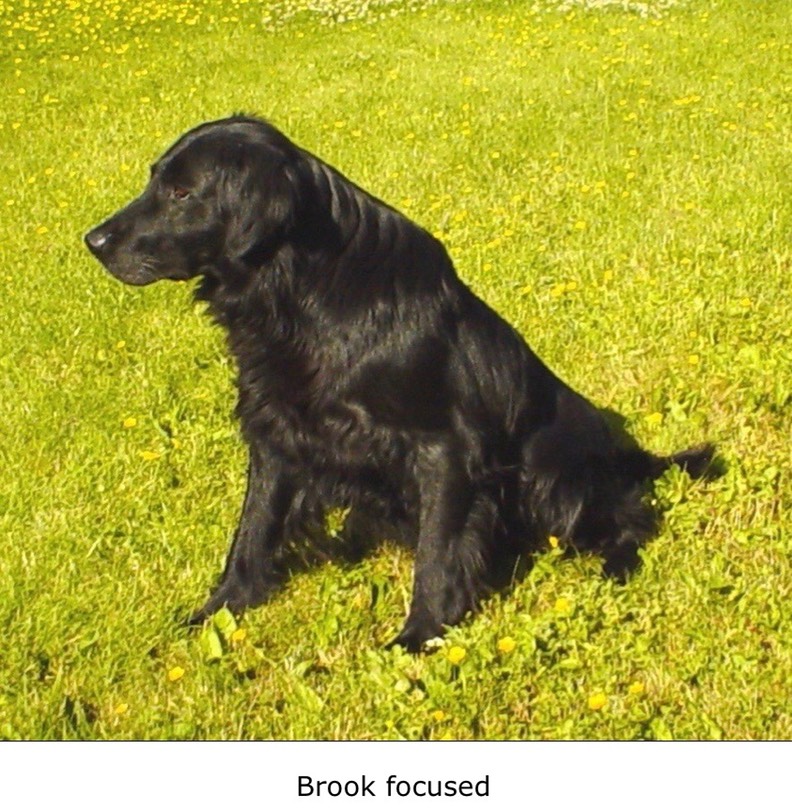
Brook was one of those dogs who did make a difference, both for the owner and for those who knew him. He was extremely obedient while being explosive in his action. In the autumn of 2006, at twelve years of age, he enjoyed picking up the whole season and although the pace was not what it had been, he found more birds than most other dogs because of his game finding abilities and lifelong experience. Brook had what you would call style. He was very fast and sensitive, and it was a delight to the eye to watch him hunt through an area. He was at the same time very placid, he preferred to lay down under the drive, but even in this position he marked every bird down and he never ran in. He was never ill, and at thirteen years of age he moved without any signs of arthritis or the like.
Brook learned to take directions almost by himself and when he was well trained he stopped like a border collie on the whistle with his forelegs down, his head lowered, a fixed look at me and the muscles tight, anticipating my slightest movements. He was a clever boy and when he got scent, he didn’t lose it. Countless are the experiences I've had with him, and stories I could tell about him both at trials and picking up. I remember one day when we were picking up at Holsteinborg Estate. Brook was sitting with my two other Flatcoats in front of me waiting for the drive. Suddenly he got up and walked behind me to relieve himself, he went back to his place and sat down without me having to say a word, being ready for action. He knew his work and had a great will to please and do the right things.
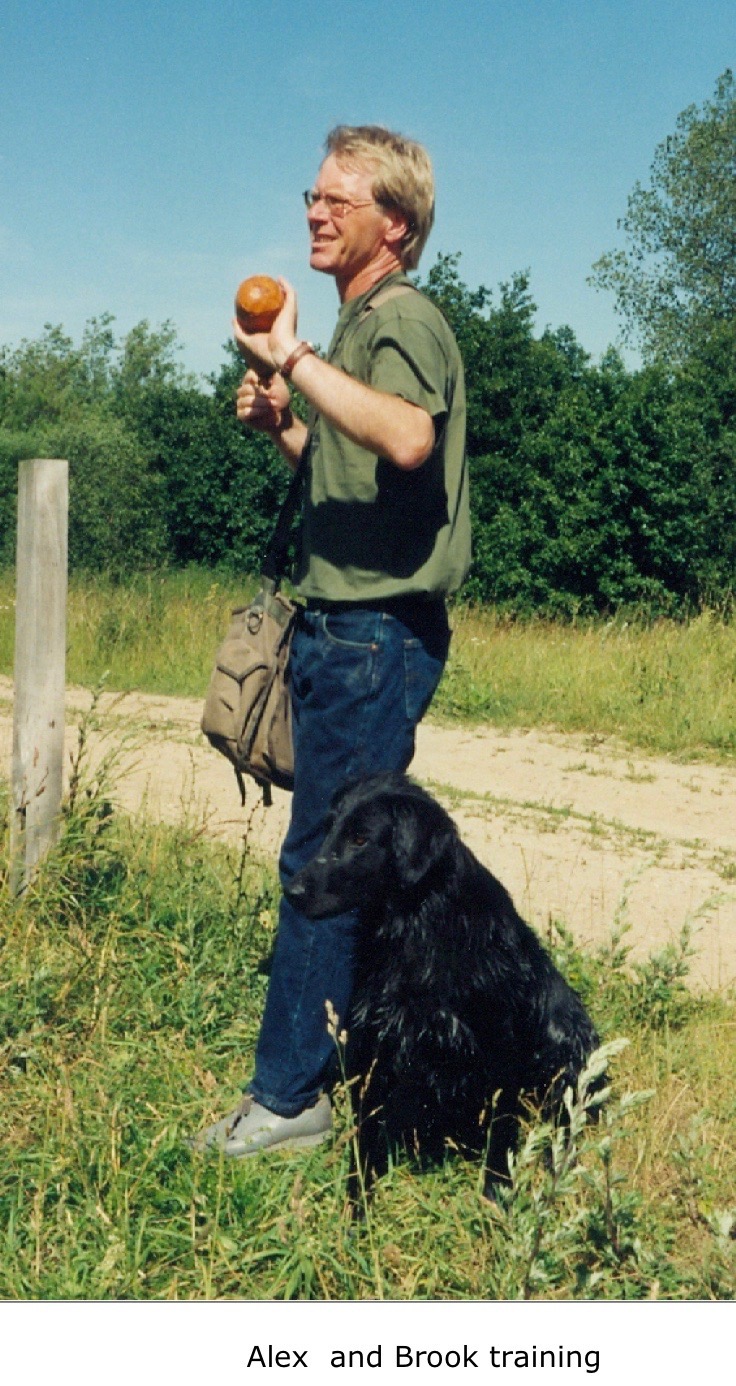
I remember once at an Any Variety Open Stake. Brook had marked and picked every bird he was sent for and we were only five or six dogs left. We were standing at a drive and Brook picked a marked bird at first behind the line. A winged bird was down about 150 meters away in a close pipe forest. A Labrador was send, but it failed, went for the wrong bird and was called up. Then Brook was sent, he took a straight line and was stopped by the whistle just before the pipe. He looked at me, was sent back into the pipe and half a minute later he came out with a cock in his mouth. The other handlers clapped their hands. He provided a solid piece of work all through the trial but it’s a part of the story, that he wasn’t placed, we called it “the Danish disease!” Things have changed and I don’t think that would happen today.
Brook was 2: nd winner once and 3: rd winner once at Winners Class Field Trials. He was 2: nd winner two times and 4:th winner once at cold game tests. Three of the winning placements were in any variety competition and he was not trialled much, my fault – I was working too much at that time.
Brook was the father of two Field Trial champions and many good dogs being Field Trial winners or getting FT awards. One of his daughters Friia Agnar Kia (FTW) was 1st winner at one trial with Brook being 2nd winner.
Another daughter of his, SE JCH Friia Agnar Windy, owned by the Swedish Zebulons kennel, was particularly successful. Windy was awarded being the best retriever in the Swedish team, the best minor breed and the third best dog overall at the CLA/The Aigle World Challenge, at Belvoir Castle, in 2005, a major international working test in Britain. She was placed as no. 3 out of the 18 dogs on day one and represented the European team competing for the Jeep International award on day two. Windy’s line has played the most important role in the Finnish working lines.
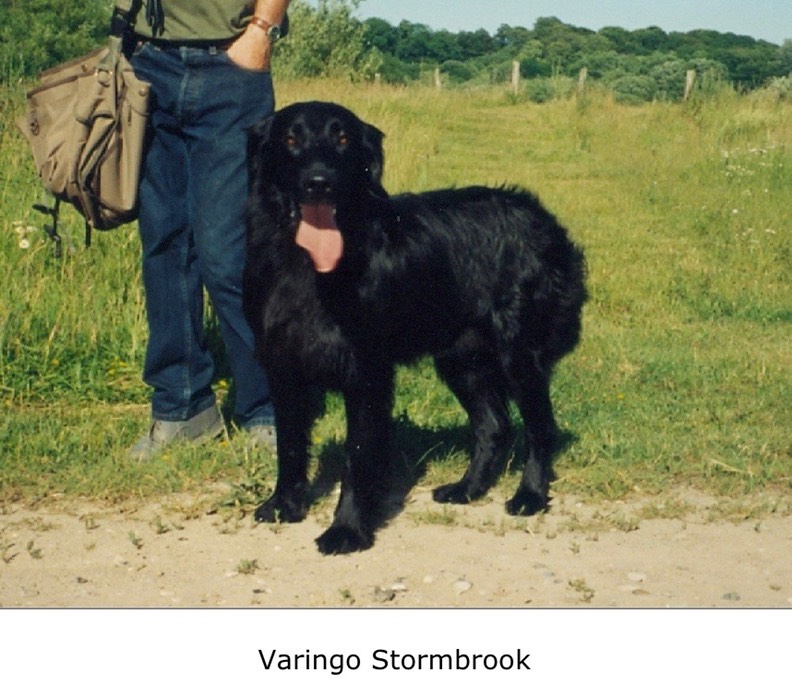
Brook appears as well behind numerous successful workers in Denmark and the other Nordic countries. He was the grandsire of the great worker Holly Hunter’s Woody Guthrie and his halfbrother Holly Hunter’s Jaspar, both being successfully used by the Waternuts kennel, and he sired Danish topdogs like Rocebell's Al Bundy, Chirley's Rosly Dande and Foldager’s Bell Armstrong. Brook made a very strong mark in my own breeding and will continue to do so.